NEW draft #COP24 text:
Here's @ActionAid reaction:
COP24: Paris Rulebook at risk of being a 'total washout'
"A rulebook that doesn’t reflect #LossAndDamage and a way forward on #ClimateFinance would be unacceptable."https://t.co/SsZ7NDTRJ1
— Harjeet Singh (@harjeet11) December 13, 2018
Student delegation from Northeastern University and Global Resilience Institute attends UN Climate Change Conference | COP24 Blog
A delegation of Northeastern University (NU) students attended the 24th Conference of the Parties to the United Nations Framework Convention on Climate Change (COP24) event in Poland. The group was led by Global Resilience Institute (GRI) Associate Director of Strategic Research Collaborations Laura Kuhl and GRI Program Manager for Research Partnerships Kyla Van Maanen.
Throughout the 10 day event, the NU team sat in on live climate negotiations between national parties, attended lectures and events at the International Pavilion, and networked at side events outside of the official grounds. This focus at this year’s COP shifted from securing national greenhouse gas reduction commitments to implementing climate change adaptation policy in practice. The student trip was supported by GRI and NU’s College of Social Sciences and Humanities, School of Public Policy and Urban Affairs, College of Science and College of Arts Media and Design.
Throughout the trip, the Northeastern students shared their thoughts and observations in the blog posts below:
_______________________________________________________________
Lost in Negotiation
By August Granath, fifth year Economics and International Affairs major, Northeastern University | 12/16/18
By Friday, the last scheduled day of COP, most observers had gone home. Negotiators had spent the night in meeting rooms and delegation offices. In the corridors, people fretted about the outcome of this article and that paragraph and expressed concern about the self-interested positions of developed country parties.
In Section E of the conference center, far away from the heart of the negotiations, a side event titled Financing Loss and Damage in LDCs offered a window into the intricacies of an issue at risk of being left behind by Katowice. Sunil Acharya, a representative of Practical Action Nepal, began by describing the impacts of climate change already being felt in his home country. The peak of the tallest mountain in Nepal had shrunk by 50 meters, the valleys were dealing with newly unpredictable flooding, and suffered new drought. He pointed out that the federal government of Nepal had not sufficiently addressed these issues, let alone planned for the future as climate change intensifies.
Five years ago, at the last COP held in Poland, the Warsaw International Mechanism for Loss and Damage (L&D) enshrined the concept that the impacts already being felt by climate change needed to be addressed by the international community. In Paris, this was carried forward by an article of the agreement that called for finance to be put towards remedying loss and damage. The Paris Work Programme being negotiated at Katowice was to turn this article into action. Unfortunately, with the closing plenary scheduled for Friday evening, things weren’t looking good for L&D at COP24.
Adam Barbosa, the lead L&D negotiator for Timor Leste, offered a view into what was taking place behind closed doors. He pointed out that developed countries are generally wary of making hard and fast rules that would make the prescription of finance for L&D explicit as they don’t want to “write a blank check.” This concern is real, as the need for L&D finance may be roughly $300 billion by 2030 according to the Climate Action Network. However, the countries disproportionately facing the brunt of these impacts, like Barbosa’s Timor Leste, have no way of covering these costs. He pointed out with frustration that L&D had been relegated to the footnotes of the current draft text despite his and other negotiators best efforts. He said that developed country parties were trying to lump L&D in with adaptation funding, a contentious issue, saying “don’t try to renegotiate Paris. Don’t try to renegotiate Warsaw… This is exactly what they are trying to do.”
Fast forward to Sunday and the dust has settled. COP24 is over and final language has been adopted. Where does L&D stand? Well, it wasn’t totally left behind. But all of the relevant language is weak and fails to address the core issue. As many pins around the venue stated: WTF? Where is the finance?
The final text mentions that a technical dialogue to support a global stocktake of climate action taken under the Paris agreement must look at efforts to “avert, minimize and address loss and damage associated with the adverse effects of climate change.”
A sad result in the #COP24 text is that #LossandDamage was not acknowledged as #climatefinance – Those who are most in need for support are left behind #COP24assessment pic.twitter.com/djKT9GhaiR
— Mattias Söderberg (@Mattias_S) December 16, 2018
It also encourages countries to provide information “related to enhancing understanding, action and support, on a cooperative and facilitative basis, to avert, minimize and address loss and damage associated with climate change impacts.” This action is not mandatory for parties to the agreement. The final language also encourages the Standing Committee on Finance to “provide input” to a report by the Warsaw Loss and Damage committee “on the sources of financial support” for the issue.
Although negotiators managed to get it into the final text, there is no doubt that advocates for L&D have been disappointed by the outcome of Katowice. As an observer, being able to see how a contentious issue such as L&D was negotiated at COP24 was incredibly revealing. I feel like I have a deeper understanding of how a complicated 133-page text of international law is created and what its outcomes really mean for people like Sunil and the rest of his country.
What can we do to make a difference? Saleemul Huq, a well-known adaptation researcher from Bangladesh, called for more research on L&D. As he pointed out in a comment during the side event, the IPCC doesn’t perform original research. It compiles existing literature. With IPCC 6 coming out in 2 years, Huq implored the folks in the room to publish work that could be included in the IPCC so that it can influence future COPs, and hopefully move the needle. With an International Affairs capstone coming up in the Spring, I may be able to turn what I’ve learned at COP24 into action, and answer his call before I graduate in May.
About the Author:
August Granath is a fifth year Economics and International Affairs major. He has worked throughout the last year as a research associate and coordinator of the State Carbon Pricing Network with Climate XChange, a research non-profit in Boston.
_______________________________________________________________
Harnessing the Power of Nature to Fight Climate Change
Emma Thornton, fourth year Environmental Science major, Northeastern University | 12/14/2018
Imagine a world in which agricultural crops are shaded and fertilized by trees, strong coastal ecosystems protect communities from storm surges, and fresh water reaches our faucets after purification through biodiverse wetlands.
Doesn’t it just make sense?
The concept of nature-based solutions has emerged as a major theme running through this COP as a method for both mitigating emissions and adapting to climate change. And for good reason. Our planet already knows how to regulate carbon, water, and nutrient cycles. Ignorant human interference is what knocked natural processes out of balance and led us to the crises unfolding today.
The sleek new technology typically presented to mitigate emissions are not the only way to restore a healthy biosphere. While geoengineering, solar farms, lab-grown meat, and nuclear power introduce tantalizing, futuristic solutions, it is imperative that we also turn to our Earth for more sustainable methods.
Nature-based solutions are cost-effective and provide environmental, social, and economic benefits. They “enhance and work with natural habitats to help people adapt to the effects of climate change and disasters.” Current examples in practice include permeable pavement, rooftop farming, and ecological corridors.
These methods account for the importance of biodiversity conservation, a key global environmental issue. Land use change, deforestation, habitat fragmentation, and climate change have resulted in a biodiversity crisis.
Indeed, the human species is known in ecology as a “global superpredator” which has driven megafauna and insects alike to extinction. Humans have caused the disappearance of 83% of wild mammals and 50% of plants, and livestock now make up more than half of the biomass of all mammals on Earth. Dozens of species go extinct every day.
Unfortunately, if you’ve read any takeaways about this Polish COP you already know that some of the parties here do not have planetary preservation in mind. Occasionally, these parties and their allies were given the platform to shift the focus away from our sustainable future.
All, apparently, in the name of profit.
I attended a panel titled Restoring degraded tropical forests: Reconciling carbon, biodiversity and community resilience, excited to learn more about carbon storage through trees and healthy soils. Instead, the Japanese- and American-sponsored panel, including members of the International Tropical Timber Organization (ITTO), used the words ‘biodiversity’ and ‘restoration’ to obfuscate and excuse practices that damage the environment, like habitat fragmentation and over-harvesting.
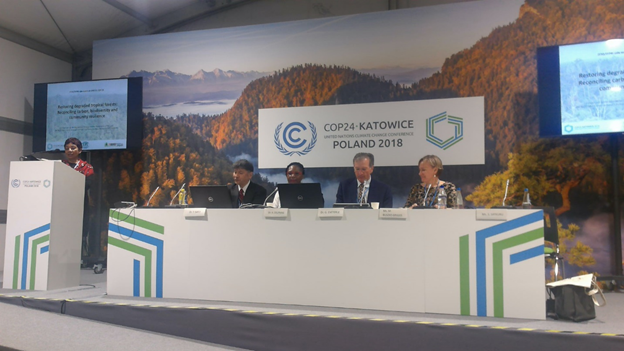
The panelists boasted the creation of new jobs for women in developing countries: jobs turning wood into charcoal and growing new trees from seeds. At first, this sounds benign, even admirable, but it was actually a cover for unsustainable resource extraction.
Many signs early on in the panel pointed to why their operation is unjust and ecologically harmful. What they left out is that old-growth trees are a quintessential part of the unique ecology in an old-growth forest. A presence that cannot be replaced by saplings. Moreover, research shows that burning charcoal results in more emissions than coal, with a payback time for the carbon debt ranging between 50 and 100 years after they’re cleared. When asked, Dr. Gerhard Dieterle of the ITTO said that the replanted trees are not native species: they are used to create fast-growing monoculture plantations with a low equilibrium carbon density. He even admitted that they’d be turned over into pulp for paper, saying “This is just the reality.”
So, I found other students and young professionals passionate about biodiversity preservation and its linkages to climate change and formed a UNFCCC YOUNGO working group on ecological conservation. Together, we are using our power to protect people and all of nature, down to the smallest insects, from fossil fuel extraction and the impacts of climate change.
I refuse to let ecological degradation remain my reality.
About the Author
Emma Thornton is a 4th year senior studying Environmental Science with a minor in Law and Public Policy at Northeastern University. She is an active member of the Terra Society, has completed co-ops at Oxfam and J-PAL, and studied international and environmental policy abroad in Costa Rica and Geneva.
_______________________________________________________________
Gilets jaunes, Ambitious Mitigation, and Just Transition (Part II)
By August Granath, fifth year Economics and International Affairs major, Northeastern University | 12/14/2018
The Paris Agreement includes a requirement for individual states to submit Nationally Determined Contributions (NDCs). These NDCs outline each state’s plan to reduce their share of global greenhouse gas emissions. The negotiations taking place in the final hours of COP24 will shape the rules for submitting the next round of NDCs in 2020. As a result, states are looking at the various policies that will most effectively achieve emission reductions. Pronounced attention has been given to carbon pricing as a mitigation policy in the various side events of the COP. During a consultation with observer organizations, UN Secretary General António Guterres mentioned that one of his primary priorities is to make “carbon pricing global.”
One of the other recurring themes of the COP has been a “just transition” which highlights the fact that transitioning to a clean energy future has dramatic social and economic implications that must be considered when crafting policy. In his blog from earlier this week, Keyon worried that such a concept could be used as a stalling tactic for countries that want to obfuscate their intention to continue supporting fossil fuel industries. In this blog, I’m examining how concepts of just transition played out during the gilets jaunes protests in Paris last month and what this means for carbon pricing as a mitigation policy. If you want a brief overview of the gilets jaunes protests, please scroll down to see Part I of this blogpost!
For people that see market based mechanisms such as carbon pricing as a crucial tool in the suite of mitigation policy, the actions of the gilets jaunes seem like a blow to the policy’s popularity in the court of popular opinion. Members of this camp are often called Climate Hawks. Others, who support the gilets jaunes on the basis of solidarity with working people, see the fight against the climate crisis as inseparable from the fight against the inequality crisis. They view carbon pricing as a tool of the elite that does not address the needs of the many. In the United States, reactions to the gilets jaunes have predictably fallen along these lines. The below Twitter exchange between the President of the Center for American Progress and the official account of the Democratic Socialists of America illustrates this.
*headdesk*
Because regressive taxes that don't make the rich and fossil fuel companies pay their fair share are, you know, bad?
Because working class people don't want to foot the bill for crappy neoliberal policies, and we know when we're being screwed?
— DSA (@DemSocialists) December 9, 2018
Are the priorities of mitigation and economic (and social) justice mutually exclusive? They don’t need to be, so long as such strategies are put together with an acute and empathetic awareness of how they will effect real people.
What is the lesson for parties to the Paris Agreement that want to incorporate carbon pricing with just transition principles into higher ambition NDCs come 2020? First of all, carbon pricing is not inherently regressive, that is, that it disproportionately burdens the wallets of the poorest. There are a variety of design options that can be used to eliminate the regressivity of the gas tax as implemented in France. The most common way to do so is through an equal rebate distributed to all citizens. In a well designed system, people in the lowest income brackets would receive more in the rebate than they would pay in higher energy costs due to the tax. Such a design would allow the benefits of a carbon price, an efficient reduction of greenhouse gas emissions, without disproportionately impacting the working class. Such a policy, The Energy Innovation and Carbon Dividend Act, was just introduced in the US House of Representatives by Ted Deutch (D – FL) with bipartisan support from eight co-sponsors.
This policy is specifically designed with mitigation in mind. It implements an emissions reduction policy that does not cause harm to the poor as a side effect. While this policy satisfies the priorities of Climate Hawks, it does not satisfy those who see climate and justice issues as inextricably linked. In the United States, the Sunrise Movement and Alexandria Ocasio Cortez have pushed the “Green New Deal” in recent weeks and have seen rapid support through grassroots organizing and a smart social media strategy. The policy is not only moonshot-like in its aspiration to move towards 100% renewables and deep decarbonization of the economy but it claims to represent a “historic opportunity to virtually eliminate poverty in the United States.” Since its inception it has garnered support from 35 house members and four senators.
As new NDCs are submitted in 2020 under the soon-to-be-completed Paris Agreement Workbook Programme, they will need to consider these issues of just transition and look at precedent to guide the design of their mitigation policy. The domestic climate policy debate is divided on the issue of just transition. Whatever happens in the next few years may be useful in informing national mitigation policy for other countries across the world. In the face of the gilets jaunes, it will be difficult for countries to see the climate crisis in total isolation from social and economic justice.
About the Author:
August Granath is a fifth year Economics and International Affairs major. He has worked throughout the last year as a research associate and coordinator of the State Carbon Pricing Network with Climate XChange, a research non-profit in Boston.
_______________________________________________________________
Gilets jaunes, Ambitious Mitigation, and Just Transition (Part I)
By August Granath, fifth year Economics and International Affairs major, Northeastern University | 12/13/2018
Last month, a quarter of a million protesters wearing yellow vests (gilets jaunes) gathered in Paris to protest a planned increase in France’s gas tax. The protests continued for four consecutive weekends and eventually attracted people who wanted to roll back French President Emmanuel Macron’s pro-business economic policies and saw the existing tax regime as unfair. Under immense pressure, Macron capitulated this past weekend and announced a freeze of the gas tax increase (and eventually eliminated the tax from the 2019 budget), an increase in the minimum wage, an elimination of taxes on overtime and pensions, and an encouragement for businesses to provide tax-exempt bonuses to employees at the end of the year.
What does this have to do with climate change and COP24? As I found out at a side event put on by the Institute for Climate Economics (I4CE), the French gas tax that brought civil unrest in Paris was originally conceived as a way to pass carbon pricing, a mitigation policy that I have worked with closely over the last year through co-op and part time work. Sébastian Postic, a French Project Manager for I4CE, briefly discussed the history of the gas tax during his presentation. In 2013, the president at the time, Francois Hollande, decided to integrate a carbon tax within an existing gas tax to avoid a veto and succeeded in getting the mitigation policy passed. It was designed to “discourage people from using diesel cars and to raise revenue for funding renewables” (US News) in the pursuit of decreasing France’s greenhouse gas emission profile.
Increasing the ambition of NDCs under the Paris Agreement has been a central talking point at this year’s COP, especially as the findings of the UN Emissions Gap report demonstrate that current commitments are not sufficient to limit global warming to 1.5 degrees. The recent IPCC report, which was not welcomed by COP24 thanks to the United States, Saudi Arabia, Russia and Kuwait, makes it clear what the world will look like if we don’t collectively hit the 1.5 degree target. With such high stakes, countries must find ways to cut their emissions. Macron has attacked this global challenge head on by putting climate action near the top of his agenda. As a result, he was recognized as a Champion of the Earth in 2018 by the United Nations Environmental Program. However, the gilets jaunes make it clear that, at least in France, he is not considered a Champion of the People.
Opening my twitter career today at week 2 of #COP24. Hopeful. But, feeling disheartened by the inability of the UNFCCC to welcome a report that they themselves commissioned https://t.co/0RZ7BSDrFV
— August Granath (@august_granath) December 10, 2018
In part II, I argue that poor design and communication is what made the French carbon tax unjust. Additionally, I look at how these themes play out in domestic climate policy and examine two proposals through a lens of just transition and political effectiveness.
About the Author:
August Granath is a fifth year Economics and International Affairs major. He has worked throughout the last year as a research associate and coordinator of the State Carbon Pricing Network with Climate XChange, a research non-profit in Boston.
_______________________________________________________________
Attending the U.S. panel session at COP24: Reflections and concerns
Emma Thornton, fourth year Environmental Science major, Northeastern University | 12/13/2018
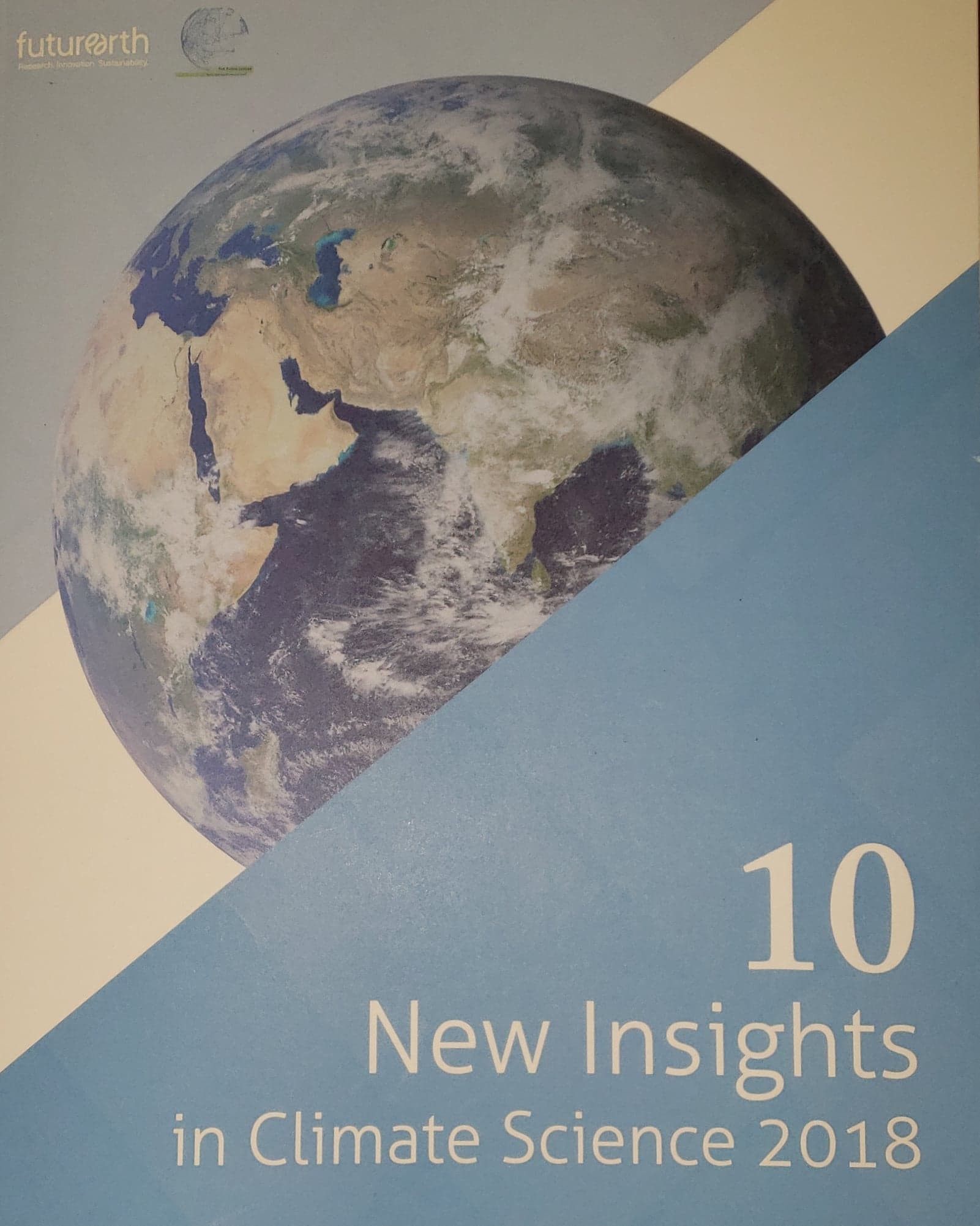 One of the most high-profile and high-drama events I’ve attended thus far was the side event titled U.S. Innovative Technologies Spur Economic Dynamism featuring President Trump’s advisor on global energy and climate issues Wells Griffith and other United States government and industry speakers.
One of the most high-profile and high-drama events I’ve attended thus far was the side event titled U.S. Innovative Technologies Spur Economic Dynamism featuring President Trump’s advisor on global energy and climate issues Wells Griffith and other United States government and industry speakers.
Griffith began the panel session with an introduction confirming the US withdrawal from the Paris Agreement and promoting the use of fossil fuels, which he claimed could be used “cleanly.”
Quickly, young protesters filled the area and shut down his speech chanting “keep it in the ground” and “shame on you.” After the protesters marched out, August, Keyon, and I sat down in the second row to continue listening to our country’s representatives. We could barely hold back our shock as others in the audience asked questions to make clear that they were climate change deniers who support US withdrawal.
What is the United States government doing participating in COP24? Why are there climate change deniers here?
Does anybody still believe that science has a role to play in policy and in these negotiations?
As an environmental science major, I came into this week searching for discussions on how the COP24 delegates use scientific evidence in their negotiations. I was especially curious about how the US would approach its refusal to welcome the IPCC report and whether the other delegates respected the gravity of its findings.
Through panels with the researchers who developed the IPCC report and Future Earth’s 10 New Insights in Climate Science 2018 report and discussions with delegates, I am assured that most of the people at the conference pay close attention to the science and use research to inform their policy decisions.
The negligence of the US position has spurred debate and tension. Everyone seems to want to know how the United States can deny the science behind climate change, which has now manifested itself in our country through increasing forest fires and extreme weather events. How can US delegates come to COP24 and continue to deny the harm climate change is wreaking on its own citizens?
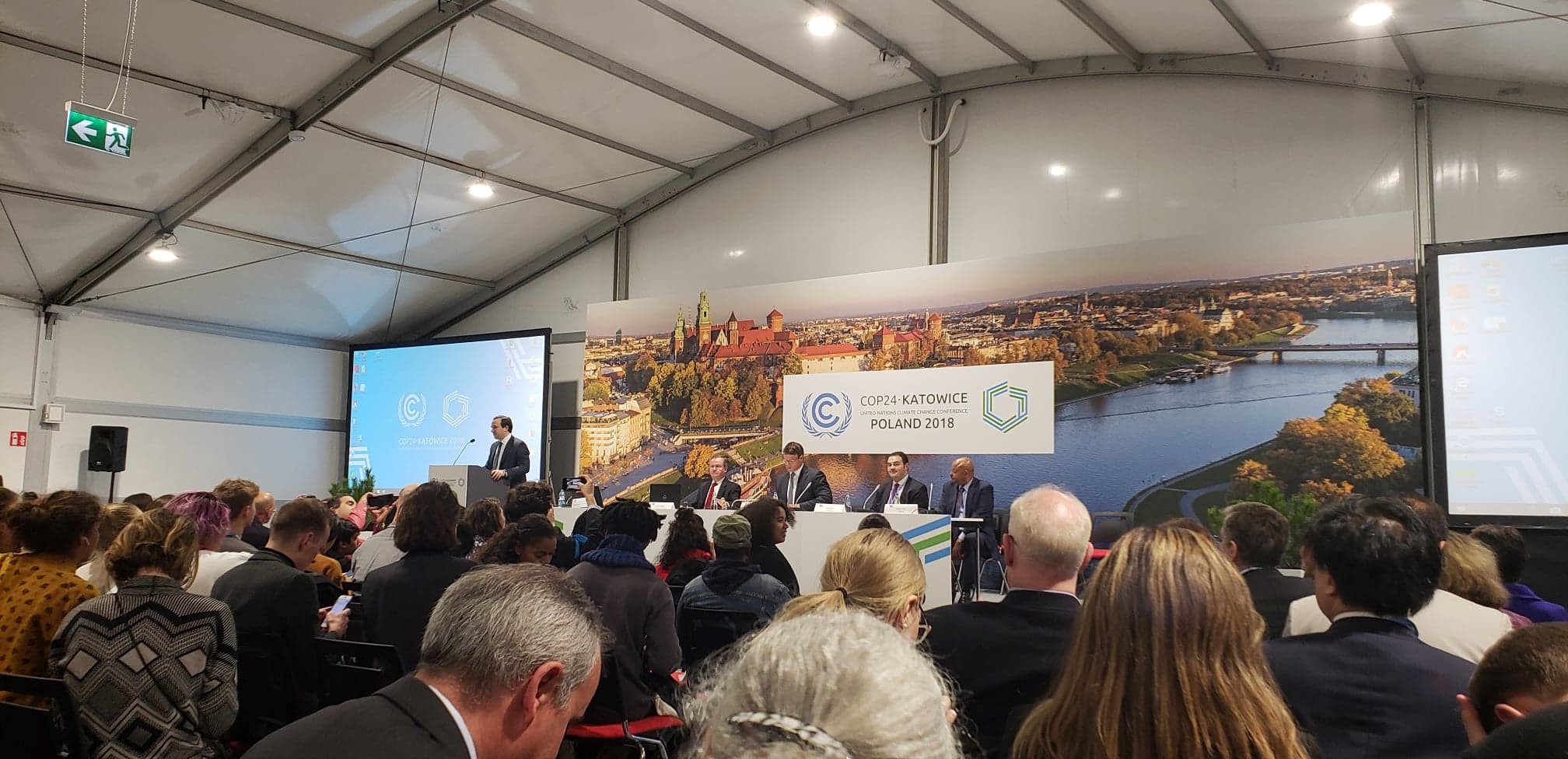
At first, I was surprised to hear the answer. They don’t. When asked about President Trump’s climate denialism, or the forest fires in California, the delegates careful to clarify that the White House decided to withdraw from the Paris Agreement not because they don’t believe in the science… and it quickly becomes clear that they don’t believe in globalism.
As Wells Griffith said repeatedly, “We cannot sacrifice economic prosperity for environmental protection.”
If the US continues to lag behind politically, even if we do continue emissions reductions, its legitimacy will fall. I see it happening now at the conference: representatives all around the world are in disbelief at the US position but continue to move forward without its participation.
About the Author
Emma Thornton is a 4th year senior studying Environmental Science with a minor in Law and Public Policy at Northeastern University. She is an active member of the Terra Society, has completed co-ops at Oxfam and J-PAL, and studied international and environmental policy abroad in Costa Rica and Geneva.
_______________________________________________________________
“A Just Transition” Draws Protest among Praise
By Keyon Rostamnezhad, third year Economics and International Affairs major, Northeastern University | 12/11/2018
Throughout the past two weeks, many buzzwords and themes dominated the negotiations at COP24 as countries worked to coalesce on key decisions. Of them all, one stood out: the call for “a just transition” in climate action. What does this mean? Frankly, nobody truly knows.
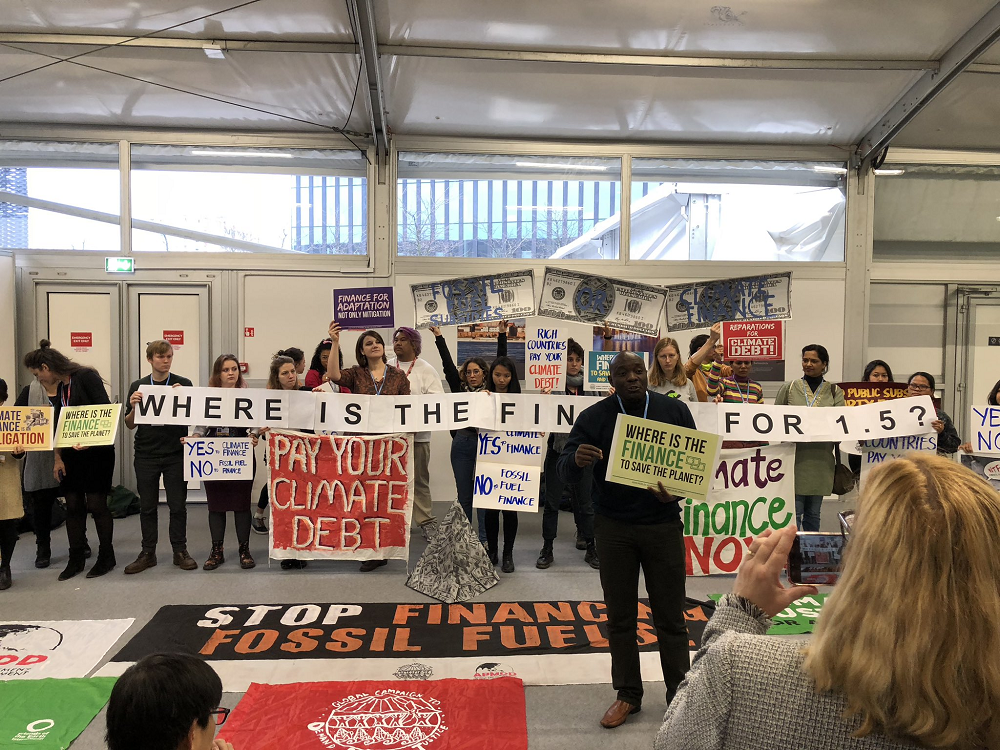
On the one hand, I sat in on a very engaging panel session on the need for inclusion of local communities to ensure their “just transition” to the changes of climate policy. An all-female (finally) panel of experts, across the global South and multinational institutions, explored the need for consideration of the serious ramifications that climate change and technological advances will have on labor and unions. By applying this theme, the panelists argued we could more inclusively reach climate action solutions that leave nobody behind. With that being said, to me it was very clear that they do not see a future for coal, and are namely focused on preparing people for the next phase.
On the other hand, “just transition” has been a tool used by some nations to encourage the continued dependence on fossil fuels and an unjustifiably slow progression. The main culprit: the U.S delegation. I attended a highly controversial panel session hosted by members from the Department of Energy, the White House team, and private sector LNG industry reps. At COP24, amid all the other panel sessions explaining detailed solutions to implementing climate action strategies, the U.S delegation showed once again that it was using every means in its power to obstruct and disrupt the negotiations, and “just transition” was the guise it used in this case to do so. This phrase was laced into all the calls for coal innovation over coal reduction by the panelists.
As I thought to myself about this dichotomy, a collection people chose to stand up instead, interrupting the event to share their qualms with this framing, including chants to “keep it in the ground!” As the political show raged on, my personal conclusions became clear: while a “just transition” is inherently a wonderful and inclusive movement, climate-leading countries need to do more to make sure it is not abused by those looking for an out, or they risk losing control of the negotiations
About the Author:
Keyon Rostamnezhad is a third year Economics and International Affairs major. He is the Vice-President of Finance at the International Relations and the incoming president of the UNA-USA. Through COP, he has helped to form a coalition of U.S University Delegates to the negotiations and is currently serving as President.
_______________________________________________________________
A Study in “Gaps”
Mary Potts, Environmental Studies and Political Science Senior, Northeastern University | 12/11/2018
UNEP Emissions Gap Report
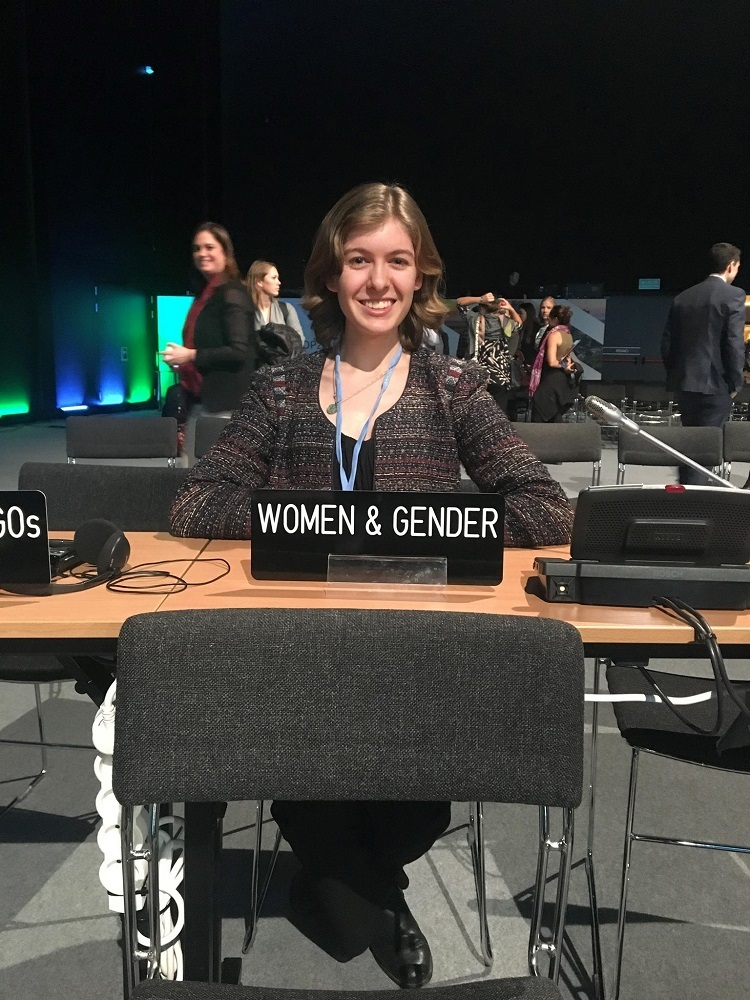 One of the most exciting events today was a presentation on the recent United Nations Environment Program’s Emissions Gap Report. The emissions gap is the difference between current emissions (based on policies outlined in the Paris Agreement, which would limit warming to 3.2°C) and the emissions needed to reach the global goal of 1.5°C or 2°C.
One of the most exciting events today was a presentation on the recent United Nations Environment Program’s Emissions Gap Report. The emissions gap is the difference between current emissions (based on policies outlined in the Paris Agreement, which would limit warming to 3.2°C) and the emissions needed to reach the global goal of 1.5°C or 2°C.
The report outlined a number of daunting challenges: greenhouse gas emissions show no signs of peaking, carbon emissions actually increased in 2017 after a three-year stabilization period, G20 is not yet on track to realize NDCs for 2030, and even if they do, NDCs are not ambitious enough to get us anywhere near 2°C. The world needs to do 3x more to get to 2°C and 5x more to get to 1.5°C.
Germany, a key funder of the Emissions Gap Report, sent their head of the Ministry of Environment, Rita Schwarzelühr-Sutter, to speak. Schwarzelühr-Sutter stressed the importance of the Gap Report for policymaking, and reiterated the overarching message that “we need to enhance ambition and we can’t wait.”
In light of that, the authors and panelists offered some encouraging news. Many statements and interventions being made at COP24 are mentioning the Gap Report as well as the IPCC 1.5°C Report, suggesting that it is actually influencing negotiations and policy. Notably, the panelists were in agreement that we were not limited by technology or even finance in meeting our global targets. They discussed solutions such as carbon pricing, phasing out fossil fuel subsidies, and sectoral emissions reductions. A clear message was that the limiting factor is political will.
Read: we can address climate change. We have the capacity to do so, right now, as we are. Personally, I find that incredibly motivating.
(wo)Men at Work
In addition to this report, today is also “Gender Day” at the UN. In some ways, that tells you everything you need to know about the success of gender mainstreaming in international governance.
While the UN has made great strides towards achieving gender parity and the explicit recognition of those goals with a specified day is a nice token in some ways, it is hard to walk around the negotiations and events at COP24 and not feel like it’s still a bit of a boys’ club.
Yesterday, the very first event of the day I attended featured an all-male panel with a female moderator, Rachel Kyte. When calling up the panelists, there was a brief delay which she filled with an amusing comment something along the lines of “better hurry up or a woman [herself] will have to take the mic. She might even say her thoughts.”
Though funny the first time, the mentions of women and their presence or not at events was conspicuously noted throughout the day and started to frustrate me. I heard jokes and apologies for “manels” (all-male panels) throughout the day, culminating in a male moderator who patted himself on the back for having 3 women out of 4 people on the panel and joked that he was feeling kind of alone up there.
Jumping forward to today, there was a plethora of gender-centric events, for example:
- “From local approaches to (inter)national policy: Gender Just Transition and Decent Work”
- “Young Women Leading on Climate: A Canadian Panel Discussion”
- “The Global Adaptation Goal and the Importance of Gender Transformative Resilience Finance”
- “Gender mainstreaming in adaptation and mitigation: A nexus approach”
Certainly these are interesting, relevant events, and I don’t mean to disparage the UN in particular. There have been some amazing women presenting and leading the conference, as was discussed in another delegate’s blog post last week. I think the UN does better than many organizations in this regard and they support many projects aimed at empowering women globally.
But, the point I want to make is that women are not (or at least should not be) an oddity in international governance. The constant pointing out of women and patting themselves on the back when their events had gender diversity continues the perception that women are a rare or special occurrence at these events.
Overall, today I framed my experience at the conference in terms of gaps. We as a global community face a huge emissions gap between where we are and where we need to be for a safe world. And there is a persisting gender gap in the leadership needed to get us there. Understanding these gaps is a critical step towards addressing them though, so we can cast today’s events in a positive light as the beginning to this process.
About the author:
Mary Potts is an Environmental Studies and Political Science senior at Northeastern University. She spent the spring semester studying climate governance, economics, and adaptation at the University of Copenhagen. Previously, she completed a co-op in the communications department at the MIT Energy Initiative.
_______________________________________________________________
An American in (or out of?) Paris
Mary Potts, Environmental Studies and Political Science Senior, Northeastern University | 12/10/2018
One thing that I was particularly interested in when going into this conference was the dynamics around the United States’ participation in negotiations, given our precarious position of having ratified the Paris Agreement, but having also made public statements to withdraw in 2020.
As an environmental studies student in the United States, I, like many others, find myself discouraged and disappointed with my country for abandoning our obligations to address climate change. In light of this lack of action at the national level, many state and local governments are stepping up and pursuing mitigation policies and actions to keep the US moving forward.
Today gave me some hope on the matter. The first panel I attended today was “Sub-National Strategies in North America for Meeting Paris Commitments,” with speakers Ken Alex (California), Ben Grumbles (Maryland), George Heyman (British Columbia), and Floriberto Vasquez Ruiz (Oaxaca).
Maryland's Ben Grumbles offers strategies at "Sub-National Strategies in North America for Meeting Paris Commitments" panel: legislation to phase out HFC pollutants, identify methane leaks to reduce emissions, reduce black carbon #COP24Katowice @Resilience_NU
— Mary Potts (@mary_e_potts) December 10, 2018
Keeping with the US perspective, Alex and Grumbles discussed a number of measures happening at the state level to combat climate change. Maryland is a part of RGGI, a nine-state cap and trade collaboration that has cut carbon emissions from the region’s power sector in half and generated $3 billion in revenue in its ten year history. The program is looking to expand in 2019 to include Virginia and New Jersey.
California is part of the Under2 Coalition, and is in the midst of extensive litigation over federal policies that interfere with the state’s ability to proceed on its environmental regulations. California has consistently been granted a waiver under the Clean Air Act to set their own stricter fuel emissions standards, but the Trump administration is now trying to withdraw that waiver.
They are cognizant of their own faults too, admitting Californians drive an astounding 350 billion miles per year. And while their overall emissions have gone down, their transportation emissions have actually increased, making them “extremely aware we need to do more.” They identified three prongs of transportation emissions to tackle: vehicles, fuels, and miles driven. Alex believes they are up for the task, noting that California’s economy has grown faster than that of the United States overall while also having stricter climate regulations, creating new jobs in energy storage and renewables.
In the pavilion area, the US has a “We Are Still In” pavilion holding events throughout the day. “We Are Still In” is a collection of mayors, governors, tribal leaders, university leaders, businesses, faith groups, and investors that have joined together and affirmed their commitment to meet the Paris Agreement targets even without formal US participation.
The conference is divided into three main sections: formal negotiations, side talks/panels, and country pavilions. The United States is unequivocally failing in the first, from its pro-coal event today to refusing to welcome the IPCC report. However, the events today gave me hope in the latter two categories—there are sizable segments in the US doing impressive work in the realm of climate policy and mitigation.
My takeaway: all hope is not lost, but 2020 is fast approaching and it is imperative that we ensure the federal government is ready to take aggressive action and not only meet, but exceed Paris obligations.
About the author:
Mary Potts is an Environmental Studies and Political Science senior at Northeastern University. She spent the spring semester studying climate governance, economics, and adaptation at the University of Copenhagen. Previously, she completed a co-op in the communications department at the MIT Energy Initiative.
_______________________________________________________________
Title: The role of women at COP24
By Sofia Cardamone, Environmental Studies and International Affairs student, Northeastern University | 12/7/2018
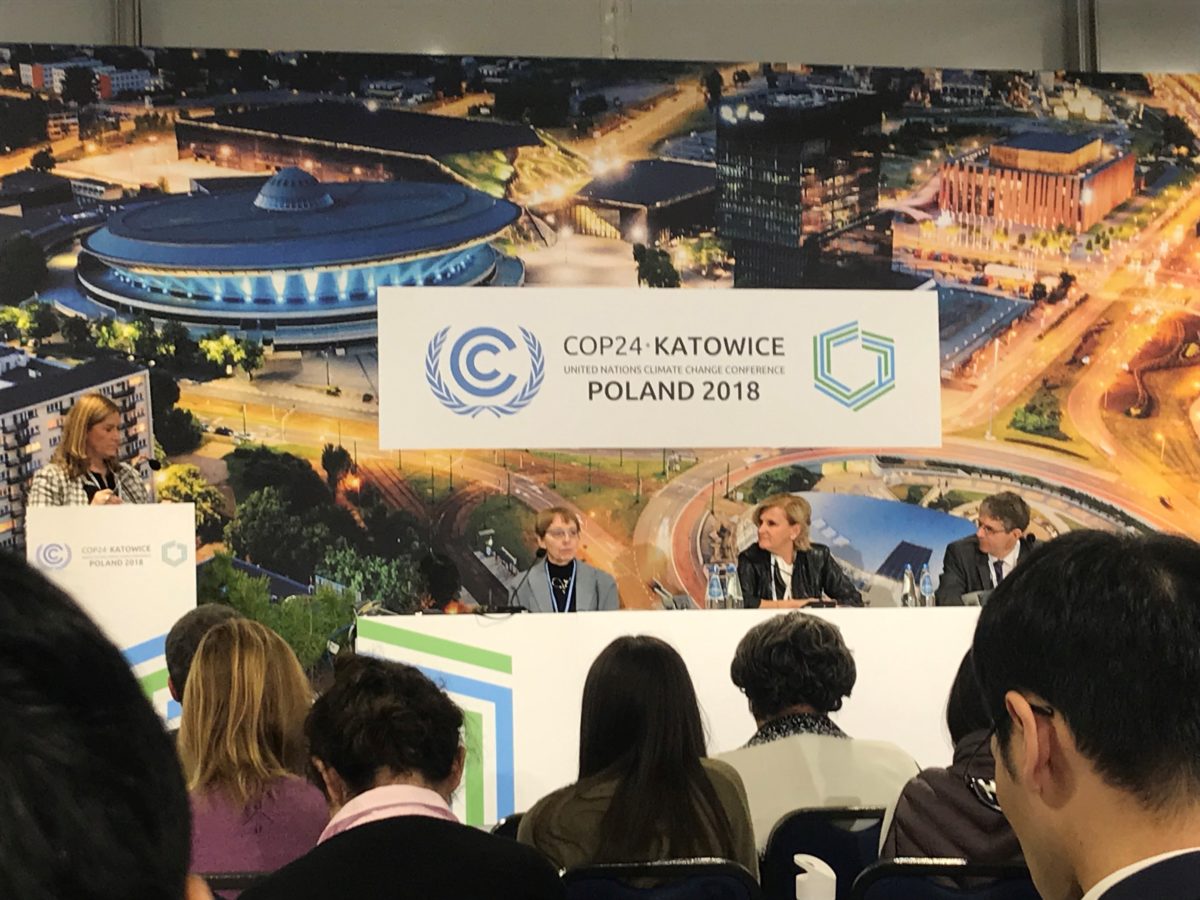 Over the course of my days at COP24, I was impressed by the amount of women presenting, attending, and leading the conference. I expected panels to be made up of primarily men— with maybe one or two women in the mix— but I was pleasantly surprised that this was not the case.
Over the course of my days at COP24, I was impressed by the amount of women presenting, attending, and leading the conference. I expected panels to be made up of primarily men— with maybe one or two women in the mix— but I was pleasantly surprised that this was not the case.
On my second day of the conference, there was a series of presentations from Solar Impulse Solutions, which ended with a speaker from Eco Wave Power, a wave energy company based in Israel. The company was founded by Inna Braverman at the age of 24. I was not only impressed by the work of her company and fascinated by the idea of wave energy, but also by her confidence, vast knowledge, and ability to command a room. I noticed that the attendees of her presentation were on the edge of their seat listening to her passionately discuss how her company has made wave energy a success.
I walked into another panel on the second day from the World Health Organization where a woman was being interviewed by a news crew outside of the room. Another Northeastern University (NU) student attending the conference, Jule, and I agreed, “Oh she’s being interviewed on TV, so she must be important.” Without thinking much more of it, we sat down and waited for the panel to begin. When it did, Dr. Maria Neira, the Director of the WHO, introduced the panel; she was the woman being interviewed outside. She, too, commanded the room. She spoke of what she wanted to accomplish while at COP24 and the immediate changes she wanted to see at COP25 with regard to prioritizing human health.
Other interesting women-led panels I attended included a handful of women who edited the UNFCCC’s SR1.5 report, and panels of indigenous women who lead entire indigenous tribes and communities.
Additionally, I noticed there were a handful of panels and events that were centered around women and science, like “WEDO: Women Demand Climate Justice”, “The role of women and young people”, and “Improving adaptive capacity of women and building resilience.” There were also several events that were gender- and equality-focused.

From my studies at NU, much of the information on women and the environment is centered around empowerment and increasing involvement from women, especially in developing countries. This was the focus of certain sessions at the conference, but watching women in positions of power was empowering. As a young woman aiming to be successful in the scientific field myself, it was comforting to see the knowledge and leadership that they contributed to making COP24 happen and the work they have done to change the planet.
_______________________________________________________________
Negotiations – The Young vs The Old
By Arief bin Johan Alimin, International Affairs & Economics student, Northeastern University | 12/7/2018
With a multitude of issues set to be resolved by the end of COP24, there is no shortage of negotiations between the various stakeholders of the conference. Most interestingly is the juxtaposition of negotiations and dialogues of the high level policy discussions between member states and the more passionate and excitable discussions of youth non governmental organizations (NGOs).
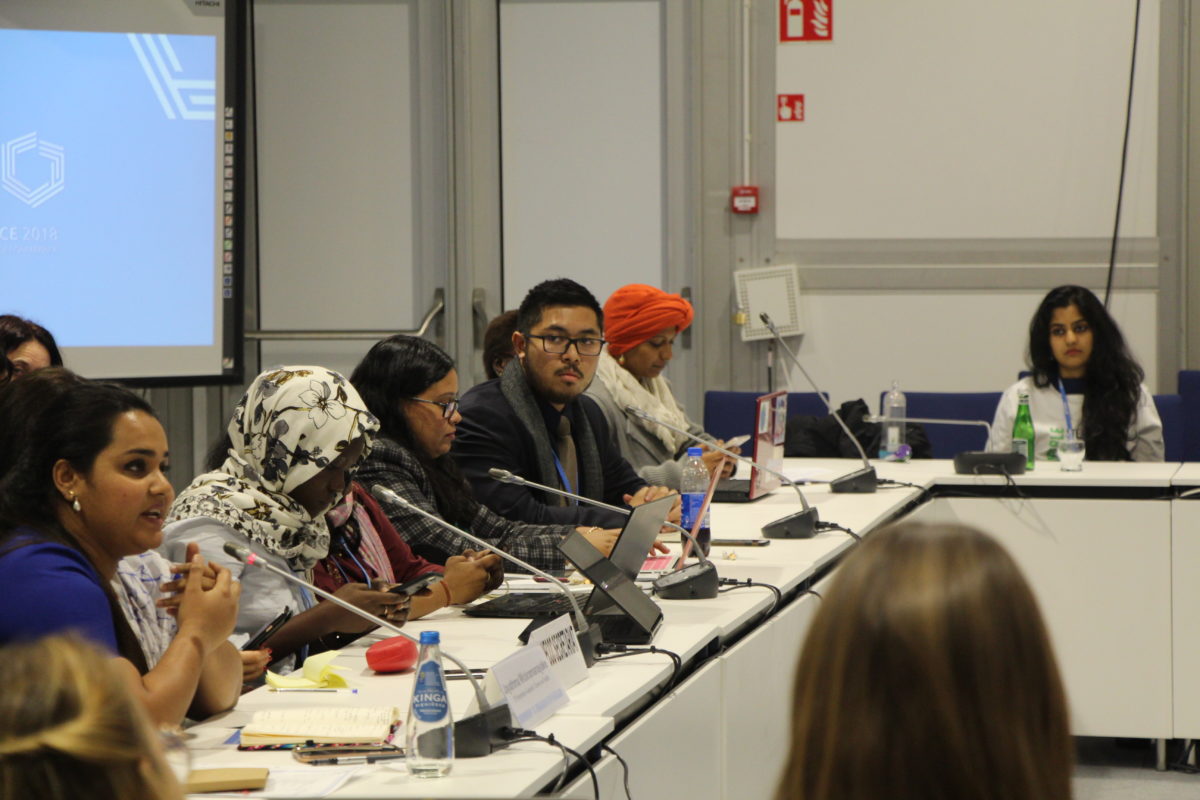 When attending the informal consultations (debates between member states that are open to observers) on climate finance, it is clear that the policymakers in the room are constrained from crafting substantial policy. When observing the first informal consultation, specifically on Article 9 of the Paris Agreement that outlines matters pertaining to finance, the energy of the room is at a low with very few countries even participating in debate. Some key observations of this include the push from the delegates of the European Union in writing new language and attempting to cajole other member states to either support or debate the language that is on the floor. All this while many member states within the G77 + China group, which notably include India, Brazil, and Saudi Arabia, have decided to engage less in substantial debate due to numerous shared concerns.
When attending the informal consultations (debates between member states that are open to observers) on climate finance, it is clear that the policymakers in the room are constrained from crafting substantial policy. When observing the first informal consultation, specifically on Article 9 of the Paris Agreement that outlines matters pertaining to finance, the energy of the room is at a low with very few countries even participating in debate. Some key observations of this include the push from the delegates of the European Union in writing new language and attempting to cajole other member states to either support or debate the language that is on the floor. All this while many member states within the G77 + China group, which notably include India, Brazil, and Saudi Arabia, have decided to engage less in substantial debate due to numerous shared concerns.
In observing these debates, there are few member states that are speaking, let alone writing new international documents. Even the facilitators of the debate attempt to convey the urgency and importance of collaboration and participation – unfortunately, this message does not seem to be taken in with great regard. As a result, the tone of the room is tense, frustrating, and overall unproductive.
On the other hand of the spectrum, numerous youth NGOs have conducted their own sessions with other important stakeholders at the conference. Under the United Nations Convention on Climate Change (UNFCCC), youth NGOs are recognized as one of the nine constituencies in the conference and are therefore invited to numerous sessions to represent the voice of younger members in society. With this, there were two sessions that were notable in underscoring a tonal shift in climate negotiations between meetings of youth groups and the meetings of member states.
At the Constituency Meeting with Executive Secretary of the UNFCCC, Patricia Espinosa, youth groups asked hard-hitting questions related to the state of negotiations from the UN’s perspective and how the needed sense of urgency in implementing the Paris Agreement does not seem to exist in high level negotiations. Through this, it was evident that younger members of society are driving the push for climate action much more than the representatives of their member states. In another meeting with the United Nations Secretary General’s Envoy on Youth, Ms. Jayathma Wickramanayake, the members of youth NGOs sought advice on how to transfer their energy, passion, and voice to those at the policy making level – especially since these policy making negotiations were being conducted in rooms next door.
In all, the United Nations should be championed for including such diverse voices at COP24. Despite this, the challenge that still exists is to identify any means to link the proposals of youth members to policymakers in the most effective manner; at the least – conveying the importance of the need to act now and act fast.
About the author:
Arief bin Johan Alimin is an International Affairs & Economics student at Northeastern University. He serves as the current Vice President of the Northeastern International Relations Council and recently co-founded the United Nations Association of Northeastern University. Arief has completed a co-op at the Ministry of Foreign Affairs Malaysia and is a member of the Malaysian Youth Delegation – a youth-led non profit focused on furthering climate action.
_______________________________________________________________
Coal Transitions in Eastern Europe
By Nick Sorokin, 5th Year Undergraduate Student, Environmental Studies and International Affairs major | 12/6/2018
Most panels I have attended at COP have consistently stressed the need for the electricity sector to drastically reduce GHG emissions as quickly as possible. Specifically, speakers from a UN-sponsored IPCC Climate Science for Policymakers event relayed that 70-85% of electricity generation will have to come from renewables by 2050 to stay within the bounds of a 1.5°C world warming scenario. Central to this goal is the idea of a just energy transition, which is the perceived global need to help shift existing energy labor towards less carbon intensive technologies. A prime candidate for this transition is the coal industry.
I attended a panel this afternoon which focused on how local communities are preparing for a post-coal future. Hosted by Bankwatch, WWF, and the Climate Reality project, panel participants from small, coal producing Eastern European towns shared stories of their local efforts to move beyond coal-centered economies. The speakers were from Bobov Dol, Bulgaria and Prievidza, Slovakia, but the panel’s focus on economic hardship, health issues, and political divides sounded a lot to me like a description of West Virginia.
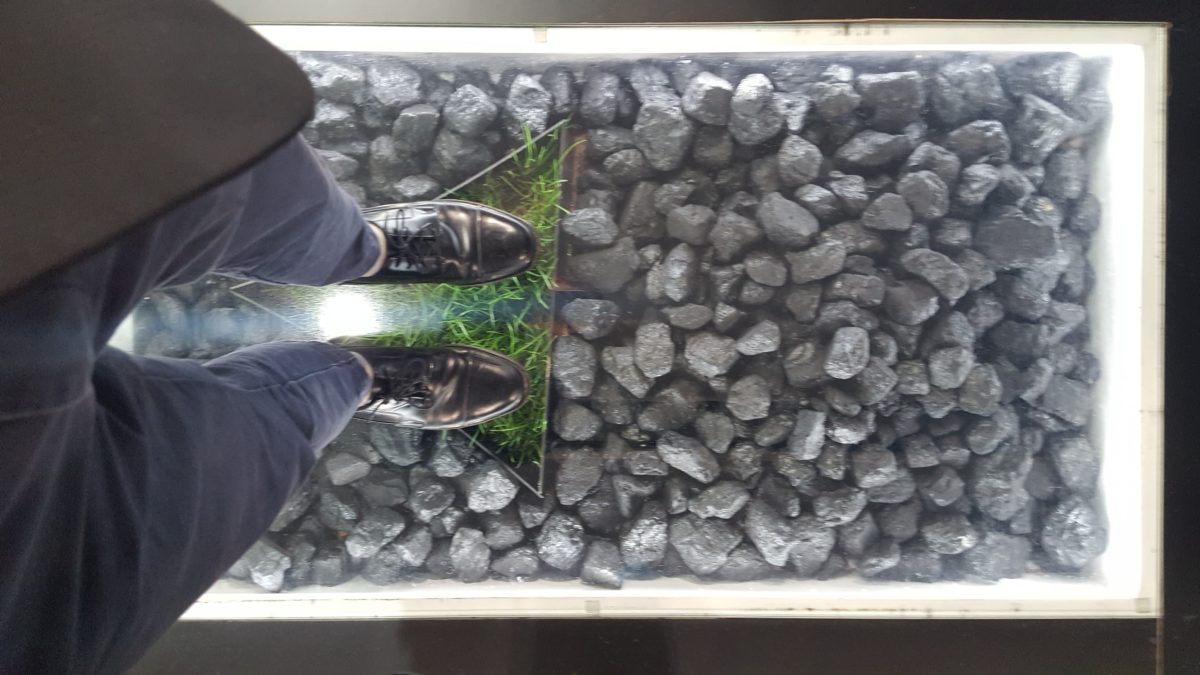
West Virginia’s economic performance and political influence are closely tied to the success of state coal companies. The state has consistently reaffirmed its commitment to coal production. But should political will materialize in WV to transition away from coal, today’s panel gave me hope that it will have established case examples to learn from.
Both of today’s Eastern European speakers recognized the need for their towns to transition away from coal despite risks of heavy political backlash. However, there exists a major disparity in hope between the two towns. The speaker from Prievidza relayed their growing optimism and employment levels in slowly transitioning away from coal, but Alojz Vlcko, mayor of Bobov Dol, described a bleak situation in which her constituency is struggling with poor air quality, unemployment anxiety, and school closings.
I must admit, I was expecting a rosier update on Bobov Dol’s journey towards less local economic reliance on coal. But I think this tale of two coal transitions translates to a broader takeaway of mine from this year’s COP. There are far more similarities between global political, energy, and economic transitions than I could have imagined. I am hopeful that an increasing number of energy transition case studies will help guide global change – especially in securing a just transition for West Virginian coal towns.
To learn more about Bobov Dol and Preividza, I’d highly recommend reading THIS UNFCCC hosted report.
About the author:
Nick has completed co-ops at the Environmental Protection Agency and Massachusetts Clean Energy Center. During his time at Northeastern he has also completed four internships across solar PV financing, smart city consulting, Department of Defense microgrid deployment, and battery energy storage research. He has completed Northeastern Dialogue of Civilization trips to Russia, Brazil, and Peru.
_______________________________________________________________
Public Health and Climate Change: A special UN and World Health Organization Climate Change Report
By Jule Davidoff, 4th Year Communication Studies Major, Northeastern University | 12/5/2018
Since arriving at COP24 Monday, I have attended a total of 18 separate events, including plenary sessions, informal meetings, and a wide variety of side events. I have learned so much more than I initially anticipated, and more than I even thought was possible in such a short timeframe. As a Communication Studies major with a minor in Art History, I am not typically exposed to the subject matter discussed at COP24 in an academic setting, so immersing myself in in-depth sessions here has been a great way to learn a lot very fast about a wide variety of topics, such as climate finance, capacity building, renewable energy sources and transition, corporate responsibility in the implementation of Paris Agreement goals, and much more.
 My favorite topic that I have learned about thus far, and one that I’ve grown quite passionate about, is the link between public health and climate change. I’ve been able to attend two events on the topic – the first was a press release put on by the World Health Organization, titled: Key Health Messages & Opportunities in the IPCC SR1.5, and the second was a side event panel, titled: 7 million unacceptable deaths. Special COP24 Health and Climate Change Report. The Press Conference debuted a report published by the WHO that details the public health impact of the IPCC Special Report 1.5 and includes 7 recommendations on how to move forward with public health as a top priority in the climate change dialogue.
My favorite topic that I have learned about thus far, and one that I’ve grown quite passionate about, is the link between public health and climate change. I’ve been able to attend two events on the topic – the first was a press release put on by the World Health Organization, titled: Key Health Messages & Opportunities in the IPCC SR1.5, and the second was a side event panel, titled: 7 million unacceptable deaths. Special COP24 Health and Climate Change Report. The Press Conference debuted a report published by the WHO that details the public health impact of the IPCC Special Report 1.5 and includes 7 recommendations on how to move forward with public health as a top priority in the climate change dialogue.
Both events were led by the impressive Dr. Maria Neira, WHO Director. Dr. Neira’s passion is infectious, and her call to action is invigorating. She is clearly deeply connected to the cause of improving international public health through reducing the negative effects of climate change, and of all the events I have attended so far, hers made me the most motivated to make a personal change to help this cause.
In addition to the sincere and enlightening dialogue presented by Dr. Neira was the interesting content proposed in the WHO’s 7 recommendations to aid in decreasing the millions of deaths caused by climate change, the majority of which are a result of air pollution. Air pollution causes young children to die of severe asthma, the elderly to die of pneumonia, and all ages in between to be highly susceptible to lung cancer and other respiratory illnesses.
Of the 7 recommendations, I was most fascinated by the content of number four: Remove existing barriers to investment in health adaptation to climate change, especially for climate resilient health systems and “climate-smart” health care facilities. This recommendation is focused, among other health-institution related matters, on building new health facilities that are powered by renewable energy sources. Dr. Neira explained that there is a surprising lack of coordination between ongoing and upcoming health projects and renewable energy implementation, especially when it comes to building hospitals in developing nations. This is shocking, and a clear indicator of a gap that needs to be bridged by increased communications between the public health and renewable energy sectors. Luckily, Dr. Neira has made it her personal and professional mission to make public health in climate change a hot button issue, even stating that it is her goal to make public health the topic of COP25.
The disappointing reality is that public health will likely never be weighed in higher regard than the economic aspects of climate change and renewable energy transfer, but this is not to say that making public health in climate change a priority is not extremely important. If you’re interested in the report put out by the WHO, you can find the entire thing here!
About the author: Jule Davidoff is a 4th year senior at Northeastern University majoring in Communication Studies with a minor in Art History. Jule’s longtime involvement in the club Trash2Treasure, a student-run recycling program that runs bi-yearly at Northeastern, has sparked her passion in environmental advocacy and climate change efforts.
_______________________________________________________________
COP24: Shifting Expectations
By Sofia Cardamone, Environmental Studies and International Affairs student, Northeastern University | 12/5/2018
 My experience at COP24 thus far has been nothing short of fascinating. Being a combined Environmental Studies and International Affairs major, the intersection of policy and climate change has been the main focus of my studies while at Northeastern. Coming into to the conference, I did not know what to expect— I assumed it would be highly technical, and would focus on fine-tuning minute details of the Paris Agreements. It did not take me long to find out that those aspects were only a fraction of the vast array of things happening at COP24.
My experience at COP24 thus far has been nothing short of fascinating. Being a combined Environmental Studies and International Affairs major, the intersection of policy and climate change has been the main focus of my studies while at Northeastern. Coming into to the conference, I did not know what to expect— I assumed it would be highly technical, and would focus on fine-tuning minute details of the Paris Agreements. It did not take me long to find out that those aspects were only a fraction of the vast array of things happening at COP24.
My first day was a whirlwind—within the first hour, I sat in what felt to me like the quintessential UN meeting room: large black seats with a pullout desk and a microphone at every chair. About 20 minutes in, Secretary General Antonio Guterres sat down to introduce the objectives of the conference (yes, I was geeking out).
The rest of the day was full of running from event to event and trying to make the most of my time here. After sitting in on several different types of sessions, I noticed there were certain panels who were attending COP24 to advocate the importance of their relative area of expertise, and/or societal problems to important heads of state.
Towards the end of the day, I sat in on one of the most interesting sessions of my whole day: a panel of tribal leaders of Amazonian states titled “The Megadriver of infrastructure in the Amazon”. Not knowing it was all in Spanish, I grabbed a set of headphones and started listening to the live translation. The panel focused on the issue that native communities in Peru had with newly built highways. They explained that contrary to common thought, highways were ruining their communities by causing deforestation, negatively affecting their cattle ranches, negatively affecting their cacao production, among other things. I immediately thought to myself, “But wouldn’t that make their communities more widely accessible? Or shed light on their culture? Wouldn’t they want to share their beliefs with the rest of the world?” The short answer was no, and I realized this was an ignorant way of thinking. The building of highways was viewed, in their eyes, as a disrespectful violation of their voluntary right to solidarity. They preferred to be isolated and protected because they felt it better conserved their livelihoods and land. It was understood that while highways may benefit broader society, it destroys their way of life.
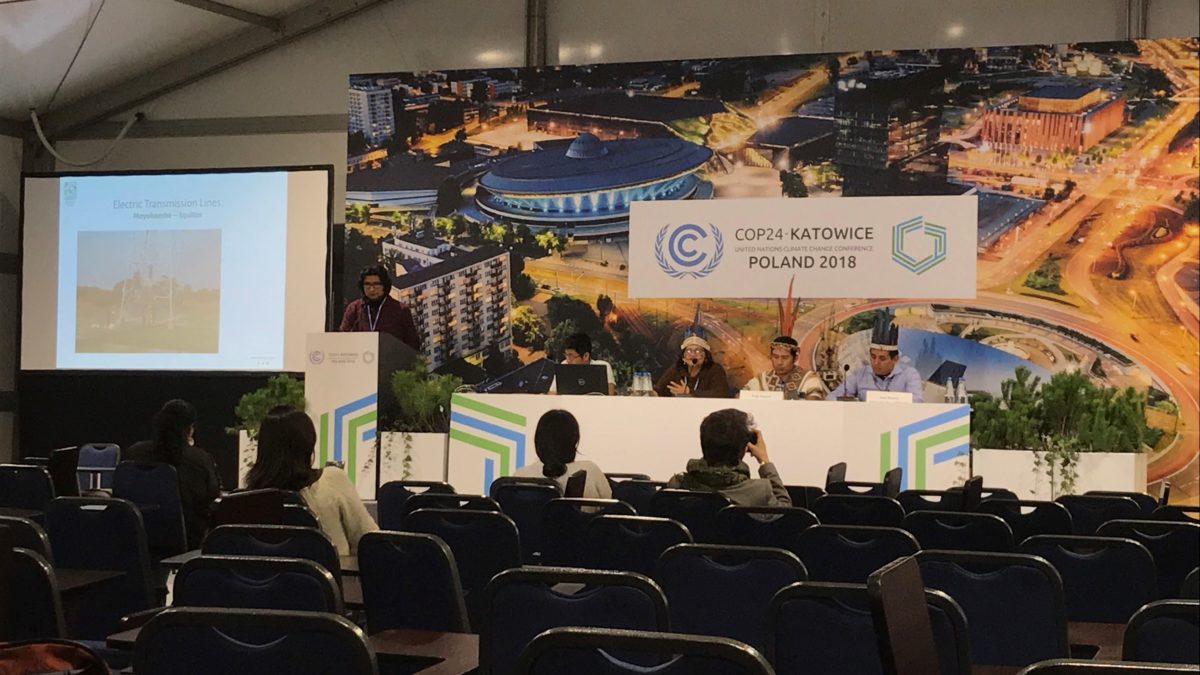
The 30-minute panel ended far too quickly and I left with a million questions I wish I had the opportunity to ask. I was intrigued by the panelist advocating that future climate agreements take into account the struggles they face, regardless of how small they may seem on a global scale. I also witnessed this type of advocacy from the World Health Organization who wanted human health to be the main focus of next year’s COP25, and from a corporate accountability panel demanding that the UNFCCC end its connection with corporations. I realized that this is what these massive international conferences are all about: demanding change and justice, and to having their voices heard.
About the Author:
Sofia Cardamone joined the Global Resilience Institute in July 2018 as a Co-op Research Assistant. She is currently pursuing a Bachelor’s degree in Environmental Studies and International Affairs with a minor in Urban Studies at Northeastern University. Prior to joining the Institute, Sofia spent the summer abroad studying climate change science and policy in Brazil and Peru, which focused on climate hazards and city resilience as well as climate adaptation in emerging economies.
_______________________________________________________________
The Polarizing Voices of COP24
By Arief bin Johan Alimin, International Affairs & Economics student, Northeastern University | 12/4/2018
 Four years has passed since the signing of the Paris Agreement – the landmark international agreement in global leaders made an ambitious promise to keep global temperature rise below 2 degrees Celsius above pre-industrial levels. Here at COP24 in Katowice, Poland – it is expected that the final plan of action to bring the Paris Agreement into full force will be established. Given recent negotiation sessions prior to COP24, many governments are not on track meet to goals set in Paris. With such high stakes, the conference can be best described as a tug of war between government legislators and the push of civil society members urging them to do more.
Four years has passed since the signing of the Paris Agreement – the landmark international agreement in global leaders made an ambitious promise to keep global temperature rise below 2 degrees Celsius above pre-industrial levels. Here at COP24 in Katowice, Poland – it is expected that the final plan of action to bring the Paris Agreement into full force will be established. Given recent negotiation sessions prior to COP24, many governments are not on track meet to goals set in Paris. With such high stakes, the conference can be best described as a tug of war between government legislators and the push of civil society members urging them to do more.
As a delegate on behalf of Northeastern University, I found myself bouncing between high level meetings and smaller working groups all related to climate negotiation. It is refreshing to see the dynamic mix of negotiations and information sessions as it seemed as though numerous stakeholders are present at the conference, as opposed to just government representatives. From heads of states to heads of indigenous tribes, from environmental policy makers to youth representatives, from large corporations to local farm owners – it seemed as though everyone was at the table in some way or another to push the conversation forward.
In good fashion, we started the day with a Press briefing with the Secretary General of the United Nations – Antonio Guterres and the Special Envoy for the slated 2019 Climate Summit – Luis Alfonso de Alba. At the session they conducted an overview of the upcoming 2019 Climate Summit to be held in New York during the United Nations General Assembly. Most interestingly, the Secretary General noted his commitment to keeping youth and civil society members a part of the process in paving the way for a climate-friendly future. This focus seemed appropriate because we ran into numerous youth-oriented and youth-run non-governmental organizations (NGOs) at the conference. With such a large presence here at COP24, it is beyond refreshing to listen to the passion of younger members of society have their voices heard by those involved with the negotiation process.
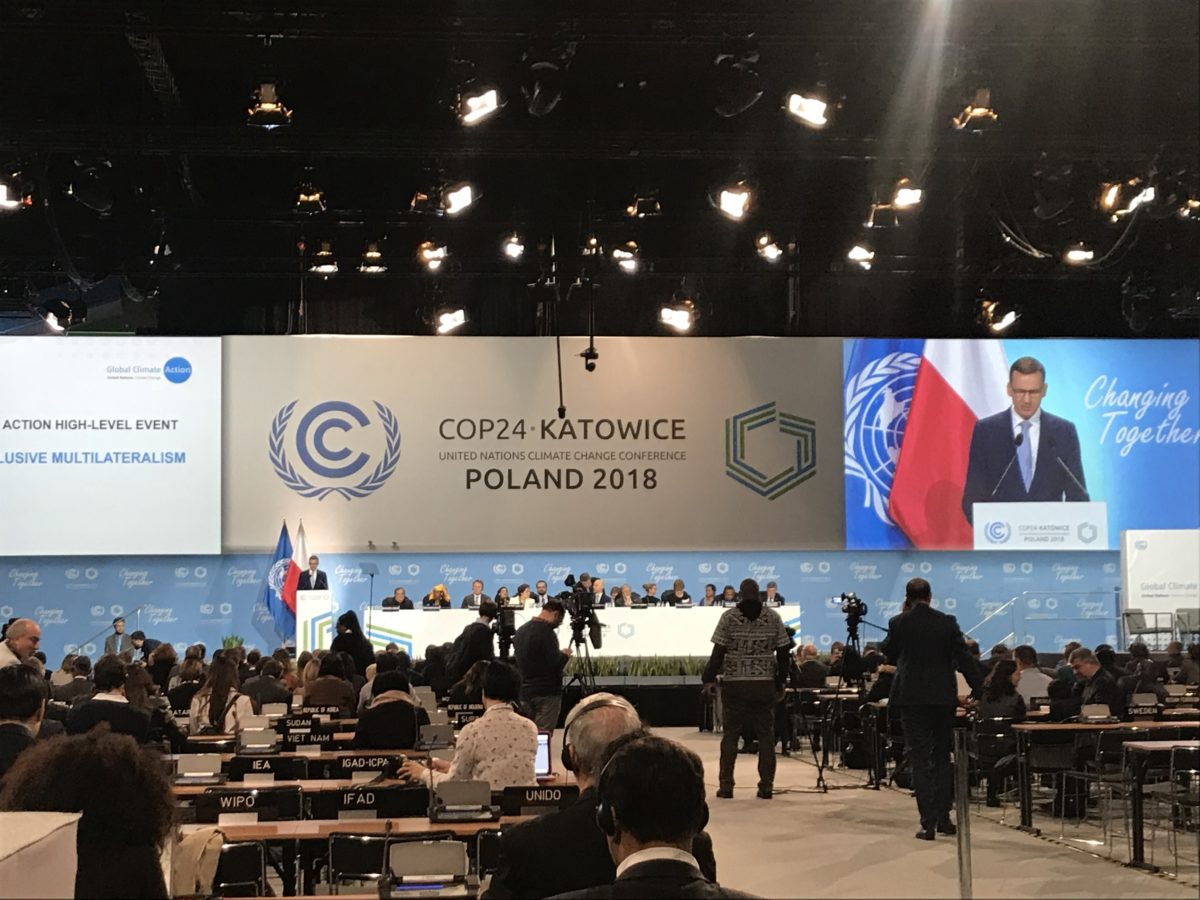
Following this, we attended a plenary session on discussing finance as a driver for climate action. At the session, the facilitator moderated questions between the CEO of ING Group – Ralph Hamers and an Indigenous Leader from Chad – Hindou Oumarou Ibrahim. While Mr. Hamers revealed new investment mechanisms from major banks geared towards sustainable investing, Ms. Ibrahim underscored the need for a greater focus to not neglect those in rural areas as they have just enough capacity to further sustainability efforts. Having a conversation between representatives of two opposite ends of the spectrum encapsulated the atmosphere of the conference so far.
As the week unfolds, I am excited to follow the progress of negotiations between these different stakeholders. With such an array of voices at COP24, I look forward to the fruitful results that hopefully will address the issues of all peoples and stakeholders affected by the threat of climate change and bring the Paris Agreement into reality.
About the author:
Arief bin Johan Alimin is an International Affairs & Economics student at Northeastern University. He serves as the current Vice President of the Northeastern International Relations Council and recently co-founded the United Nations Association of Northeastern University. Arief has completed a co-op at the Ministry of Foreign Affairs Malaysia and is a member of the Malaysian Youth Delegation – a youth-led non profit focused on furthering climate action.
_______________________________________________________________
COP24 – The Path Forward
by Nick Sorokin, 5th Year Undergraduate Student, Environmental Studies and International Affairs major | 12/3/2018
This is the last week of my Undergraduate career at Northeastern. It is also the first week of my attendance at COP24, and a new path forward.
The new path of which I speak is global in scale and interconnected in nature. It is intended to guide a globalized world economy towards an endpoint of effective climate change mitigation and adaptation. It’s three primary avenues are sustainability, equity, and resilience.
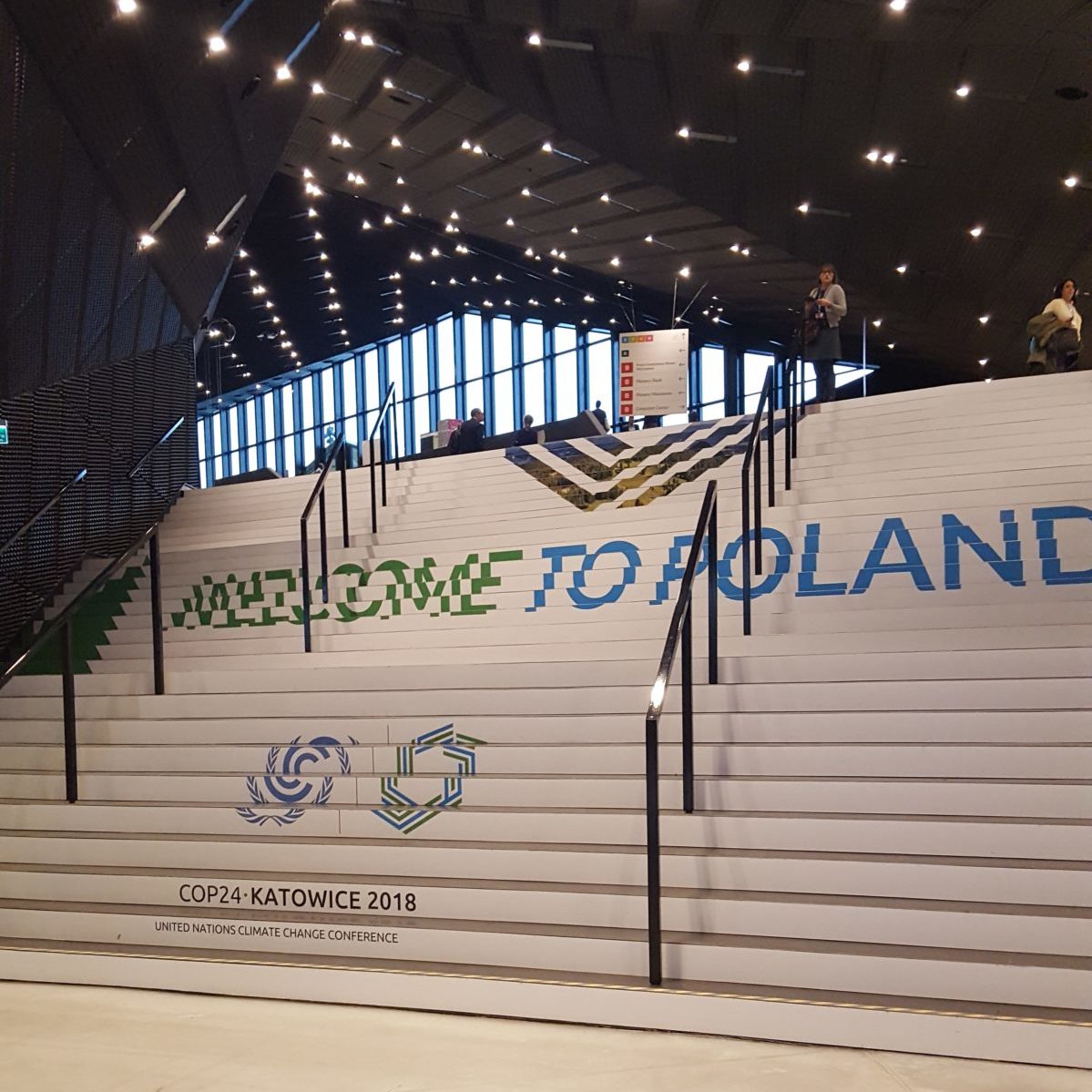
But the path is still under construction.
COP21 produced the Paris Agreement as a blueprint for global climate action. This year’s COP24 in Katowice, Poland will help finalize the Paris blueprint and identify financing commitments and mechanisms.
Although our Northeastern delegation arrived with only time to register and briefly explore the venue today, the excitement in the air was infectious. While I partially attribute this positive energy to attendees being able to keep their shoes on during the security checkpoint, it’s clear to me that I’ll enjoy my time here.
While the main focus of the conference is multi-lateral negotiations and agreements between nation-states, there is are a plethora of side events and informal working sessions to attend. The majority of side events are open to all, but others involve pre-registration and special ticketing.
I was able to attend an open side event today which served as a platform for global climate advocacy groups. During this event, the CliMates organization’s presentation stood out to me most.
They explored how there is a growing desire amongst younger people to pursue environmental sustainability-focused jobs, but found that there will be a significant shortfall between job seekers and jobs available. Given their framing of this jobs market disparity, CliMates called for the need to incorporate a sustainable, environmentally conscious mindset into every sector. The reason this presentation stood out to me was that it underlined one of the main subtexts of COP24, which is the need for a ‘just transition’. One of the key themes of this transition is the need to retrain workers in the fossil fuel industry to jobs in lesser carbon emitting sectors.
Overall – I very much enjoyed my first day at COP24 and would like to thank Northeastern SPPUA, CSSH, CAMD, COS and GRI for sponsoring our trip. I’ve benefited immensely from my experiences and opportunities at Northeastern, and hope to help identify other research universities, NGOs, and IGOs to partner with in the area of resilience research and sustainable development.
About the author:
Nick has completed co-ops at the Environmental Protection Agency and Massachusetts Clean Energy Center. During his time at Northeastern he has also completed four internships across solar PV financing, smart city consulting, Department of Defense microgrid deployment, and battery energy storage research. He has completed Northeastern Dialogue of Civilization trips to Russia, Brazil, and Peru.
_______________________________________________________________
COP24 Day 1: Getting Oriented and Exploring
by Jule Davidoff, Northeastern University Class of 2019 | 12/3/2018
Today was our first day at the COP, so we headed to Katowice around 2 p.m. so we could arrive in time to register. The size of the conference center is notable, and nearly everything in sight is branded with COP24 signage. The map here shows the entire layout of the conference, and each block contains specific types of meeting rooms, attractions, and pavilions.
 I think the best way to describe the first day is by what surprised me most: First, it was very interesting to notice how many different languages can be heard while walking around the conference, many of which are unrecognizable to my English-only speaking self. Secondly, I was very impressed to see how intricate and beautiful the country pavilions and non-governmental organization (NGO) pavilions are. The country pavilions are located in block E, and all have their own unique design and layout that represents the country’s culture.
I think the best way to describe the first day is by what surprised me most: First, it was very interesting to notice how many different languages can be heard while walking around the conference, many of which are unrecognizable to my English-only speaking self. Secondly, I was very impressed to see how intricate and beautiful the country pavilions and non-governmental organization (NGO) pavilions are. The country pavilions are located in block E, and all have their own unique design and layout that represents the country’s culture.
It is also striking how much time and effort is put into the construction of the different pavilions and the conference center itself, and how many workers are present to make the event flow so smoothly. Certain NGOs also have their own pavilions in blocks E and H, such as Business Hub, powered by IETA: Climate Challenges, Market Solutions, and the Nordic Council of Ministers, and the World Wildlife Fund (WWF) (titled #PandaHub), among dozens of others. Each pavilion has its own side events, many of which run all day long, concurrent with each other and other events happening throughout the convention.
Lastly, I was surprised by how many people were at the conference. Of course, I was expecting a lot of people in attendance, but between national delegations, NGO-attendees, and the many other categories attendees can fall under, the sheer number of individuals walking around in combination with people in the many side events and meeting rooms was a lot to take in. At the same time, it was inspiring and exciting to see how many people have traveled from across the world to attend the conference.
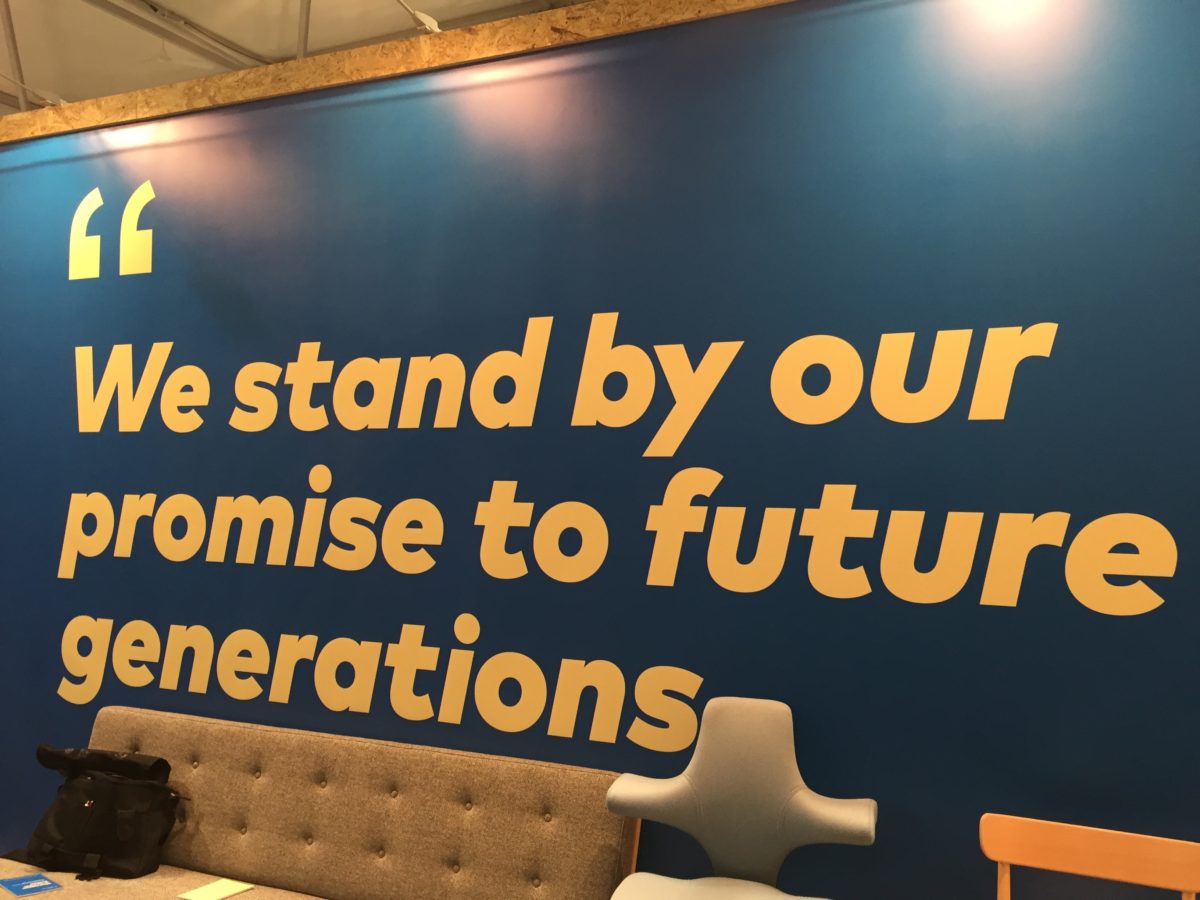
I’m really glad we were able to gather our bearings today when there weren’t many events happening so we can head in early tomorrow morning with fresh minds and an understanding of the layout of the convention. I’m looking forward to jumping into the convention and attending the many side events that have peaked my interest, such as ”Climate is changing. Shouldn’t food systems change too?“, put on by the Food and Agriculture Association (FAO), and “Ocean and Climate: the evidence unwrapped,” put on by Plymouth Marine Laboratory and hosted by the WWF, just to name a few.
We can’t wait to share more in-depth updates about the conference in the coming days!
_______________________________________________________________
